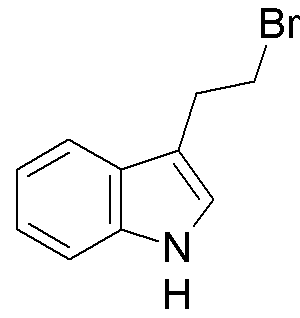3-(2-Bromoethyl)indole is widely utilized in research focused on:
- Synthetic Chemistry: This compound serves as a key intermediate in the synthesis of various indole derivatives, which are important in developing pharmaceuticals and agrochemicals.
- Pharmaceutical Development: It is used in the creation of novel drug candidates, particularly in oncology and neurology, due to its ability to modify biological activity through structural changes.
- Biological Research: Researchers employ this compound to study its interactions with biological systems, helping to elucidate mechanisms of action for potential therapeutic agents.
- Material Science: It finds applications in the development of advanced materials, such as polymers and coatings, where its unique properties can enhance performance.
- Agrochemical Formulation: The compound is explored for use in developing new pesticides and herbicides, offering potential advantages in efficacy and environmental safety compared to traditional chemicals.
General Information
Properties
Safety and Regulations
Applications
3-(2-Bromoethyl)indole is widely utilized in research focused on:
- Synthetic Chemistry: This compound serves as a key intermediate in the synthesis of various indole derivatives, which are important in developing pharmaceuticals and agrochemicals.
- Pharmaceutical Development: It is used in the creation of novel drug candidates, particularly in oncology and neurology, due to its ability to modify biological activity through structural changes.
- Biological Research: Researchers employ this compound to study its interactions with biological systems, helping to elucidate mechanisms of action for potential therapeutic agents.
- Material Science: It finds applications in the development of advanced materials, such as polymers and coatings, where its unique properties can enhance performance.
- Agrochemical Formulation: The compound is explored for use in developing new pesticides and herbicides, offering potential advantages in efficacy and environmental safety compared to traditional chemicals.
Documents
Safety Data Sheets (SDS)
The SDS provides comprehensive safety information on handling, storage, and disposal of the product.
Product Specification (PS)
The PS provides a comprehensive breakdown of the product’s properties, including chemical composition, physical state, purity, and storage requirements. It also details acceptable quality ranges and the product's intended applications.
Certificates of Analysis (COA)
Search for Certificates of Analysis (COA) by entering the products Lot Number. Lot and Batch Numbers can be found on a product’s label following the words ‘Lot’ or ‘Batch’.
*Catalog Number
*Lot Number
Certificates Of Origin (COO)
This COO confirms the country where the product was manufactured, and also details the materials and components used in it and whether it is derived from natural, synthetic, or other specific sources. This certificate may be required for customs, trade, and regulatory compliance.
*Catalog Number
*Lot Number
Safety Data Sheets (SDS)
The SDS provides comprehensive safety information on handling, storage, and disposal of the product.
DownloadProduct Specification (PS)
The PS provides a comprehensive breakdown of the product’s properties, including chemical composition, physical state, purity, and storage requirements. It also details acceptable quality ranges and the product's intended applications.
DownloadCertificates of Analysis (COA)
Search for Certificates of Analysis (COA) by entering the products Lot Number. Lot and Batch Numbers can be found on a product’s label following the words ‘Lot’ or ‘Batch’.
*Catalog Number
*Lot Number
Certificates Of Origin (COO)
This COO confirms the country where the product was manufactured, and also details the materials and components used in it and whether it is derived from natural, synthetic, or other specific sources. This certificate may be required for customs, trade, and regulatory compliance.


